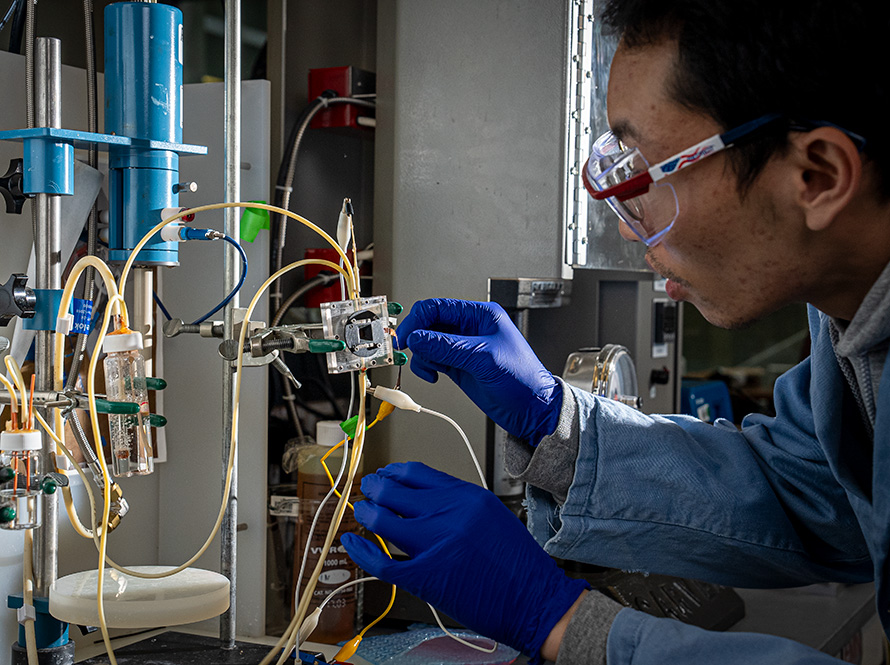New research has revealed the fundamental mechanisms that limit the performance of copper catalysts – critical components in artificial photosynthesis that transform carbon dioxide and water into valuable fuels and chemicals.
In a study co-led by scientists at Lawrence Berkeley National Laboratory (Berkeley Lab) and SLAC National Accelerator Laboratory, researchers have used sophisticated X-ray techniques to directly observe how copper nanoparticles change during the catalytic process. By applying small-angle X-ray scattering (SAXS) – a technique traditionally used to study soft materials like polymers – to this catalyst system, the team gained unprecedented insights into catalyst degradation that has puzzled scientists for decades.
The work is part of the Liquid Sunlight Alliance (LiSA) DOE Energy Innovation Hub. Led by Caltech in close partnership with Berkeley Lab, LiSA brings together more than 100 scientists from national lab partners at SLAC and the National Renewable Energy Laboratory, and university partners at UC Irvine, UC San Diego, and the University of Oregon. Launched in 2020, this multi-institutional collaboration is developing the scientific principles needed to efficiently and selectively generate liquid fuels from sunlight, water, carbon dioxide, and nitrogen. (Learn more about the LiSA collaboration in this roundup, “Five Ways LiSA is Advancing Solar Fuels.”)
The CO2 electrochemical reduction reaction (CO2RR) process has intrigued scientists for decades as a promising way to make fuel and other important compounds. A big breakthrough in the 1980s identified copper as a high-performing catalyst for transforming CO2 and water into starting ingredients for liquid fuels and chemicals like ethylene and ethanol. Subsequent studies showed that copper contains active sites where electrocatalysis takes place: electrons from the copper surface interact with carbon dioxide and water in a sequence of steps that transform them into products like ethanol fuel and ethylene for plastics. Researchers are investigating ways to tune these active sites to selectively produce specific chemicals, including ethanol, ethylene, and propanol.
But copper’s super-catalytic properties quickly degrade during CO2RR, diminishing its performance over time. Through the years, researchers have looked for ways to prevent this performance loss, but the chemical and physical processes that control this degradation were unclear.
With the Berkeley Lab and SLAC researchers’ study – published recently in the Journal of the American Chemical Society – those processes are less mysterious thanks to an innovative application of scattering and imaging techniques that allowed the researchers to identify and observe two competing mechanisms that drive copper nanoparticles to the brink of degradation in a CO2RR catalyst: particle migration and coalescence (PMC), in which smaller particles combine into larger ones, and Ostwald ripening, where larger particles grow at the expense of smaller particles.

Ershuai Liu of Berkeley Lab’s Chemical Sciences Division setting up the electrochemical cell – custom-designed for CO2 reduction experiments – at Berkeley Lab’s LiSA research facility. (Credit: Marilyn Sargent/Berkeley Lab)
“Our approach allowed us to explore how the nanoscale size distribution evolves as a function of operating conditions, and to identify two different mechanisms that we can then use to guide our efforts to stabilize these systems and protect them from degradation,” said Walter Drisdell, a co-corresponding author on the paper who is also a staff scientist in Berkeley Lab’s Chemical Sciences Division and principal investigator with LiSA.
In this study, the researchers used a technique called small angle X-ray scattering (SAXS) at the Stanford Synchrotron Radiation Lightsource (SSRL) at SLAC to track the size and shape distributions of uniformly shaped 7-nanometer copper oxide nanoparticles under various electrical voltages in a custom-designed electrochemical cell with an aqueous electrolyte.
When running the CO2RR reaction for an hour, the researchers found that the PMC process dominates in the first 12 minutes, and then after that, Ostwald ripening takes over. Under the PMC mechanism, the nanoparticles migrate and coalesce into clusters. When the Ostwald ripening process takes over, smaller nanoparticles dissolve and redeposit onto larger nanoparticles, the same process that can create crunchy water crystals in ice cream.
Further analyses in the current study showed that lower voltages, where reactions are slower, trigger the migration and agglomeration of the PMC process – and larger voltages speed reactions up, increasing the dissolution and redeposition process of Ostwald ripening.
Separate in situ X-ray absorption spectroscopy (XAS) measurements at SSRL show that the copper-oxide nanoparticles reduce to copper metal before restructuring begins, and post-mortem imaging confirmed that the nanoparticles had migrated and formed large agglomerates. The imaging was achieved using advanced electron microscopy techniques at Berkeley Lab’s Molecular Foundry.
“These results suggest various mitigation strategies to protect catalysts depending on the desired operating conditions, such as improved support materials to limit PMC, or alloying strategies and physical coatings to slow dissolution and reduce Ostwald ripening,” Drisdell said.
In future studies, Drisdell and team plan to test different protection schemes, and continue working with their LiSA colleagues at Caltech to design catalytic coatings with organic molecules, and test these coatings’ ability to steer CO2RR reactions into producing specific fuels and chemicals.
This work was supported by the DOE Office of Science. The Molecular Foundry is a DOE Office of Science national user facility at Berkeley Lab. The Stanford Synchrotron Radiation Lightsource (SSRL) is a DOE Office of Science national user facility at SLAC National Accelerator Laboratory.

